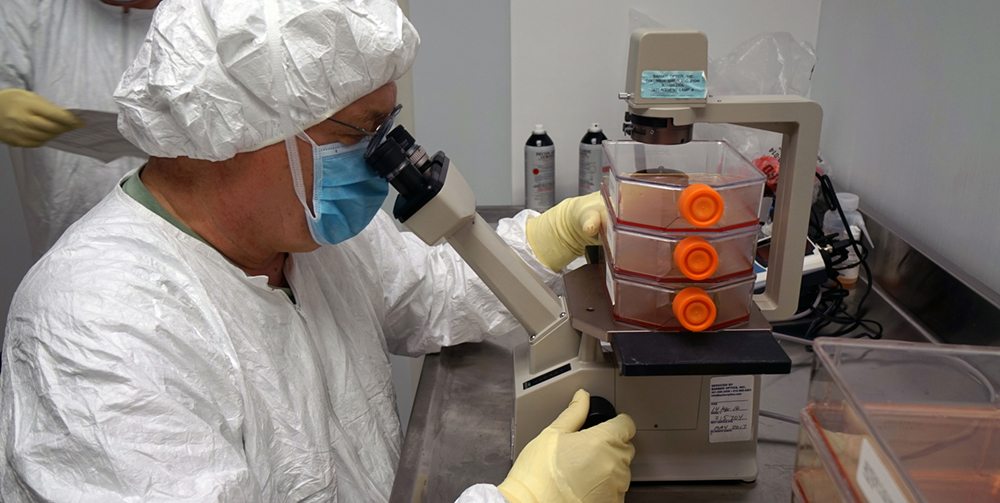
Harvard and Walter Reed scientists collaborate in an effort to protect humans from a mosquito-borne virus.
by Col. Nelson L. Michael and Col. Stephen J. Thomas
Researchers at Walter Reed Army Institute of Research (WRAIR) in Silver Spring, Maryland, moved quickly to develop and begin testing a Zika vaccine candidate early this year. The fast-moving virus, which is transmitted by infected mosquitos and through sexual contact, alarmed the world as it spread through South and Central America, causing serious birth defects. A preclinical study published June 28 in the journal Nature indicated the feasibility of a vaccine to prevent Zika infection in humans. The study was completed by WRAIR and collaborators at the Beth Israel Deaconess Medical Center at Harvard Medical School.

BREEDING TEST SUBJECTS
A. aegypti, the mosquitoes that transmit the Zika virus, are reared by the thousands at WRAIR for use in preclinical Zika vaccine experiments and research. (Photos by Jonathan Thompson, WRAIR Medical Audio Visual)
The WRAIR and Harvard teams are now testing this vaccine in a second preclinical model. If everything goes well, the plan is to start human testing later this year. On July 6, WRAIR announced a cooperative research and development agreement with Sanofi Pasteur to transfer its vaccine technology to the pharmaceutical company to explore advanced and larger-scale manufacturing and production.
“The Army has an interest in supporting development of countermeasures against Zika,” said Dr. George V. Ludwig, acting principal assistant for research and technology for the U.S. Army Medical Research and Materiel Command. “Infectious diseases have traditionally been the greatest threat to Soldier health and readiness both in the field and in the garrison. …Similarly, it’s also important to support the health and welfare of our Soldier-dependent population here in the United States by finding ways to protect them from this emerging disease.”

INFECTION TIME
Uninfected A. aegypti, the main transmitters of the Zika, Dengue and chikungunya viruses, are transported in pint containers from the main WRAIR insectary to specialized laboratories to be infected with the Zika virus.
The mosquitoes that transmit Zika virus, Aedes aegypti, are also the ones responsible for spreading the dengue, yellow fever and chikungunya viruses. These mosquitoes, and the viruses they carry, have been expanding their geographic reach. Until last year, Zika was limited to the tropics of the Indian Ocean basin and the South Pacific. The wide range of A. aegypti and their ability to breed anywhere there is even a tiny amount of stagnant water makes them hard to control. That’s why prevention strategies are needed that are directed at the mosquito as well as the human host.
Although Zika manifests clinically in only 20 percent of those infected and generally causes a mild disease of self-limited fever and muscle or joint pain, the virus can cause neurologic disease and death in developing fetuses. Zika virus is also unique among mosquito-borne diseases in that it can be transmitted through sexual contact.
However, a vaccine that limits the amount of virus in the blood will likely prevent transfer of the virus from mother to child or between sexual partners and interrupt transmission within at-risk populations.
The Zika virus disease was originally discovered in 1947, in the Zika Forest of Uganda. Dr. Alexander J. Haddow was the first to study the virus after a rhesus monkey developed a fever from the bite of an A. africanus mosquito.

ZEROING IN ON ZIKA
Russell A. Olson, Viral Vaccines Section head at WRAIR, examines cell cultures for the Zika virus.
His grandson, Dr. Andrew D. Haddow, followed in his footsteps to become a virologist at the U.S. Army Medical Research Institute of Infectious Diseases, where he also studies the disease on the other half of the research spectrum—basic research. He and his colleagues are doing the work that lays the foundation for understanding the virus.
“Everyone here understands the gravity of the situation, and the impact that our work will make for not only our service members but also populations around the globe,” said Haddow. “Our number one goal is to move good science forward as rapidly as possible.”
For more information, see the Walter Reed Army Institute of Research website: http://wrair-www.army.mil/.
COL. NELSON L. MICHAEL earned his M.D. and Ph.D. from Stanford University and graduated summa cum laude from the University of California, Los Angeles with a degree in biology. He also trained in internal medicine at Harvard.
COL. STEPHEN J. THOMAS earned his M.D. from Albany Medical College and a B.A. with honors in biomedical ethics from Brown University.
RELATED LINKS
WRAIR Center for Infectious Disease Research
Inside the US Army lab racing to create a Zika vaccine
An Army Specialist Helped Create a Possible Zika Vaccine
This article will be printed in the October – December 2016 issue of Army AL&T magazine.
Subscribe to Army AL&T News, the premier online news source for the Acquisition, Logistics, and Technology (AL&T) Workforce.







